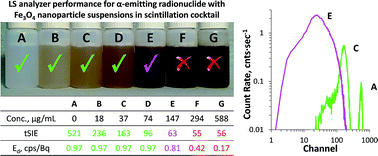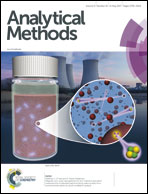Magnetic iron oxide nanoparticles for the collection and direct measurement of adsorbed alpha-emitting radionuclides from environmental waters by liquid scintillation analysis†
Abstract
Radioactive contamination, be it from accidental or intentional release, can create an urgent need to assess water and food supplies and the environment, and monitor human health. In the event of such an emergency, rapid and efficient methods may be needed to assess contamination levels in scores of samples within a short time frame. Internalized exposure to radionuclides that decay by alpha (α) emission can be especially hazardous, given the strongly ionizing nature of the α particle. Unfortunately, the determination of α-emitting radionuclides using traditional radioanalytical methods is typically labor and resource intensive and time consuming. In an effort to devise methods that are fast, require little labor and laboratory expendables, and minimize the use of toxic or corrosive reagents, researchers at PNNL have evaluated superparamagnetic nanoparticles as extracting agents for α-emitting radionuclides from chemically unmodified and acidified (pH 2) aqueous systems. It is demonstrated that bare magnetite nanoparticles exhibit strong affinity for two representative α-emitting radionuclides (241Am and 210Po) from two representative aqueous matrices (river and ground water). Furthermore, use of the superparamagnetic properties of these nanomaterials to concentrate the analyte-bearing solids from the bulk aqueous solution has been demonstrated. The nanoparticle concentrate can be either directly dispensed into a scintillation cocktail, or first dissolved and then added to a scintillation cocktail as a solution for an α-emission assay by liquid scintillation analysis. Despite the severe quenching caused by the metal oxide suspensions in the cocktail, the authors have demonstrated that modern liquid scintillation analyzers can report accurate α activity count rates; the upper limits of nanoparticle suspension concentrations in a cocktail are reported for cases wherein normal instrument count mode and a quench correction protocol are used. Discussions are provided on the presented sample processing and analysis method, the improvement (lowering) of minimum detectable activity concentrations using the nanoparticle-based assay method, and the quenching effects of nanoparticle suspensions in a scintillation cocktail.



 Please wait while we load your content...
Please wait while we load your content...